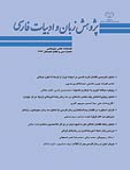بررسی زبان سبک ادبی پسامدرن در رمانهای ایرانی
محورهای موضوعی : پژوهشهای ادبیات کلاسیک ایرانساناز رحيمبيكي 1 * , محمود براتي 2 , محمدرضا نصر اصفهاني 3
1 -
2 -
3 -
کلید واژه: نقد ادبی سبکشناسی ادبیات داستانی رمانهای پسامدرن ایران عناصر زبان,
چکیده مقاله :
طي چند دهه اخير همراه با موج جهانی ادبیات پسامدرن، رمان هايي در عرصۀ ادبيات داستاني ايران پدید آمده اند که مدعی رویکردی نوین در نگرش و نگارش این نوع ادبی هستند که طبعاً زبان و سبک را هم دربرمیگیرد. زبان، برجستهترين عنصر سبكي در مطالعات ادبي است. از طرفي هر نوع تغيير در فرم و محتوای زبان اثر ادبي، نشاندهندۀ دگرگوني در نگرش خالق اثر نسبت به جهان پيرامون خويش و انسان است. بنابراين آنچه مهم مينمايد، بررسي تأثیراتی است كه فلسفۀ ادبیات پسامدرن براي زبان رمان ایرانی ايجاد كرده است؛ زیرا مقولۀ زبان، عناصر و مفاهیم وابسته به آن، در فلسفۀ ادبیات پسامدرن جایگاهی محوری دارد، به نحوی که ادبیات پسامدرن را با چگونگی کاربست زبان برای بازآفرینی جهان داستانی میشناسند. این مقاله ضمن تحلیل الگوهای زبانی در رمان پسامدرنیستی ایران، چگونگی به کارگیری عناصر زبانی این رمانها را با نگاهی انتقادی تبیین ميكند. برای کشف تمهیدات زبانی سبکساز در این مقاله، عناصر زبانی این آثار با الهام از رویکرد سبکشناسی لایهای در سه سطح آوایی، واژگانی و نحوی، شناسایی و دستهبندی شدند و امکانات زبان متن در هر لایه توصیف و نشان داده شد و اینکه هر یک از این خصوصیات زبانی در لایۀ مورد نظر، چه امکاناتی را در جهت بازتولید نگرش پسامدرن یا دوری از آن در جهان داستاني این رمانها انجام میدهد. پس از بررسی زبان این آثار مشخص شد در سطح آوایی مشخصه سبکی متمایزی ندارند و در سطح واژگانی، در هر دو حوزه کلی زبان در مفهوم کاربرد ادبی و محاوره ای گام برمی دارند و همچنین دارای انسجام دستوری نیز هستند.
In recent decades, along with the global wave of postmodern literature, we have been witnessed novels in Persian fiction which claim to have new attitudes and a new approach to writing in this genre which naturally includes language and style. Since language is the most important element of the style in literary studies, any change in the form and content of the language in a literary work would be a sign of alteration in the artist attitude towards his/her external and internal world. So, it seems significant to analyze the influences of the postmodern literature philosophy on the language of Persian novels, since language and its associated elements and concepts have a central status in postmodern literature known by its way of using language to recreate the fictional world. The present article will analyze the linguistic patterns of Persian postmodern novels, and with a critical approach, explain different ways in which linguistic elements have been used in these novels. In order to find the linguistic arrangements that create this style, the linguistic elements ,inspired by layered stylistics, will be determined and categorized at three levels: phonetic, lexical, and syntactic. Also, linguistic characteristics of the text and their roles in reproducing the postmodern attitude or moving away from it at these three levels are described and examined in the fictional world of these novels. Investigating the language in these works reveals no distinctive stylistic properties at phonetic level; and at the lexical level, words have both literary and conversational functions. They are also grammatically cohesive.

